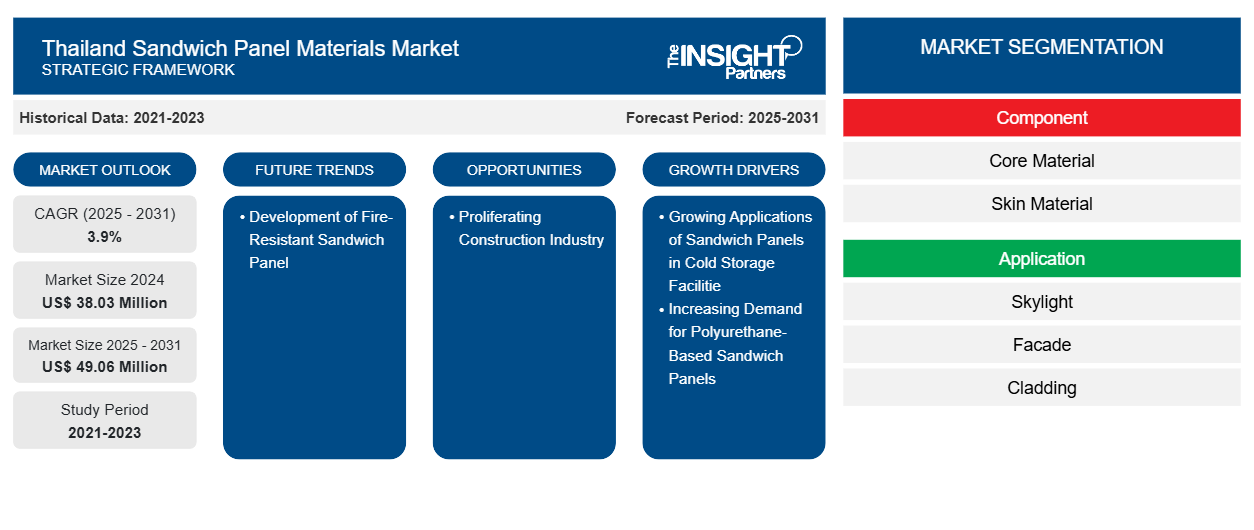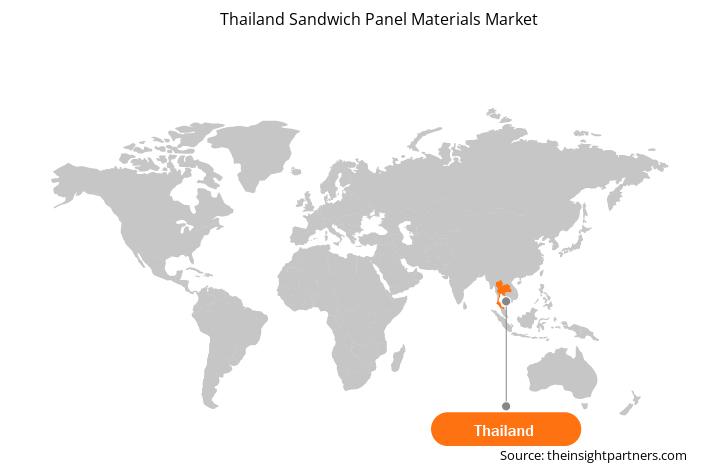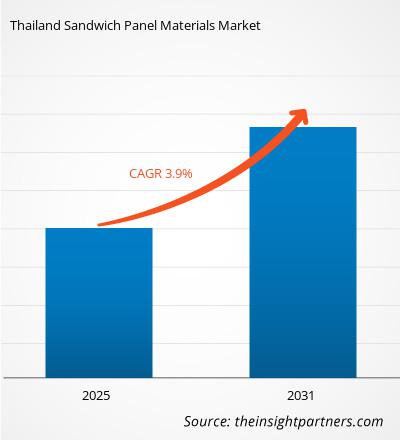泰国夹层板材料市场规模预计将从 2024 年的 3,803 万美元增至 2031 年的 4,906 万美元。预计 2025 年至 2031 年期间市场复合年增长率为 3.9%。防火夹层板的发展可能仍是泰国夹层板材料市场的一个主要趋势。
泰国夹芯板材料市场分析
政府为提高食品安全并减少收获后损失而采取的举措促进了先进冷藏解决方案的采用。对更好的食品安全的需求、泰国不断增长的出口市场以及夹层板在冷藏设施中的日益广泛的应用推动了泰国夹层板材料市场的增长。预计在预测期内,蓬勃发展的建筑业将为泰国夹层板材料市场的增长提供巨大的增长机会。全国范围内的快速城市化增加了对高效、经济和耐用的建筑材料的需求。为了满足这些需求,使用具有优异的隔热、防火和轻质性能的夹层板。它们在建设现代基础设施(包括商业建筑、住宅综合体和工业设施)中的使用可能会大幅增加。根据 YCP Holding 的 Solidiance 报告,泰国的建筑业可以利用政府开发许多经济重点领域的大规模计划,这可能会创造对建筑材料的需求。这为泰国的建筑业者提供了机会,并相应地调整了他们的专业。大湄公河次区域 (GMS) 经济走廊的发展为泰国的建筑业带来了重大机遇。在东盟开发银行(ADB)的支持下,湄公河流域各国建立经济区将在未来几年促进关键交通基础设施和通信网络的发展。
泰国夹层板材料市场概况
在泰国,夹层板材料因其出色的隔热性能而在建筑行业获得了极大的关注。它们具有出色的耐用性和强度,并且重量轻且用途广泛。夹层板还有助于减少碳足迹。它们的隔热性能可以节省能源,从而使建筑实践与可持续发展目标保持一致。这些优势促进了它们在住宅、商业、工业和机构建筑项目中的应用。它们在泰国的仓库、工业棚、冷藏设施、洁净室、实验室、办公楼和防火围护结构中得到广泛使用。
定制此报告以满足您的需求
您可以免费定制任何报告,包括本报告的部分内容、国家级分析、Excel 数据包,以及为初创企业和大学提供优惠和折扣
泰国夹层板材料市场:战略洞察

- 获取此报告的关键市场趋势。这个免费样品将包括数据分析,从市场趋势到估计和预测。
泰国夹层板材料市场驱动因素和机遇
聚氨酯夹层板需求不断增长
泰国正在经历快速的城市化和基础设施建设,这导致对高效耐用的先进建筑材料的需求增加。聚氨酯 (PU) 板因其卓越的隔热性能、轻质特性以及在各种建筑应用中的多功能性而成为建筑商和承包商的首选。此外,聚氨酯板在各种建筑应用中的多功能性,包括屋顶、墙面覆层和冷藏设施,正在推动其在该国的需求。聚氨酯夹层板特别适用于需要防火结构的建筑,并在大型工业厂房、车库、移动房屋、展览馆、体育馆、购物中心、机场、发电厂、医院、地层和高层办公楼中有着广泛的应用。这些面板易于安装,并且只需极少的维护即可提供长期性能。泰国越来越重视建筑业的现代化,再加上人们越来越意识到节能材料的好处,正在加速采用聚氨酯复合板。此外,泰国还有许多国内夹层板供应商,例如 Metecno Pannelli Co Ltd、FATEK Works Co Ltd、RICCO、Prowall (Thailand) Co Ltd、Thai Syncon and Supplies Co Limited 和 Kitti Manufacturing Company Limited。因此,对聚氨酯夹层板的需求不断增长,推动了泰国夹层板材料市场的增长。
建筑业蓬勃发展
泰国最雄心勃勃的计划之一是开发东部经济走廊,从芭堤雅延伸至罗勇府。这一战略项目旨在推动国家经济扩张,将泰国定位为东盟领先的工业、基础设施和城市发展经济区。该计划设想建立各种行业,包括汽车、电子、数字技术、医疗保健、生物燃料、生物化学品、航空和物流。机场、海港和铁路网等关键基础设施的建设和大量投资将是支持这些广阔经济区的关键。政府和私人投资者优先考虑可持续和节能的建筑方法,这与夹层板提供的优势非常吻合。此外,由于需要更快地完成项目并节省成本,泰国对预制和模块化建筑的偏好日益增加,这可能会在预测期内推动对夹层板材料的需求。
泰国夹层板材料市场报告细分分析
有助于得出泰国夹层板材料市场分析的关键部分是组件、应用和最终用途。
- 根据组件,市场细分为核心材料(聚氨酯、聚异氰脲酸酯、矿棉、发泡聚苯乙烯等)和表皮材料(聚碳酸酯、玻璃纤维增强板、铝、钢等)。 2024 年,表皮材料部分占据了更大的市场份额。
- 在应用方面,市场分为天窗、外墙、外墙覆盖层、户外等。户外部分在 2024 年占据了最大的市场份额。
- 根据最终用途,市场分为住宅、商业、工业和机构。住宅市场在 2024 年占据了最大的市场份额。
泰国夹层板材料市场份额分析(按地区)
泰国夹层板材料市场报告的地理范围侧重于历史市场收入和预测方面的市场情景。
泰国住宅领域见证了曼谷周边地区经济的快速发展,公寓市场也因此不断扩大。此外,在政府批准东部经济走廊之后,工业领域和城市发展旨在将泰国打造为东盟领先的经济区,并成为外商投资的重点地区。据 BCI Central 称,该国建筑业确实有许多项目正在进行中,目前该国超过 50% 的项目处于建设阶段。住宅领域备受关注,有超过 3,300 个活跃项目。在泰国北部,由于旅游业的发展促进了当地经济,住宅建筑行业呈现上升趋势。因此,泰国建筑业的强劲增长推动了对夹层板的需求;这反过来又推动了对夹层板材料的需求。
泰国夹层板材料市场区域洞察
Insight Partners 的分析师已详尽解释了预测期内影响泰国夹芯板材料市场的区域趋势和因素。本节还讨论了泰国夹芯板材料市场在北美、欧洲、亚太地区、中东和非洲以及南美和中美洲的细分市场和地理位置。

- 获取泰国夹层板材料市场的区域具体数据
泰国夹层板材料市场报告范围
| 报告属性 | 细节 |
|---|---|
| 2024 年的市场规模 | 3,803万美元 |
| 2031 年市场规模 | 4906万美元 |
| 全球复合年增长率(2025 - 2031) | 3.9% |
| 史料 | 2021-2023 |
| 预测期 | 2025-2031 |
| 涵盖的领域 | 按组件
|
| 覆盖地区和国家 | 泰国
|
| 市场领导者和主要公司简介 |
|
泰国夹层板材料市场参与者密度:了解其对业务动态的影响
泰国夹芯板材料市场正在快速增长,这得益于终端用户需求的不断增长,而这些需求又源于消费者偏好的不断变化、技术进步以及对产品优势的认识不断提高等因素。随着需求的增加,企业正在扩大其产品范围,进行创新以满足消费者的需求,并利用新兴趋势,从而进一步推动市场增长。
市场参与者密度是指在特定市场或行业内运营的企业或公司的分布情况。它表明在给定市场空间中,相对于其规模或总市场价值,有多少竞争对手(市场参与者)存在。
在泰国夹层板材料市场运营的主要公司有:
- 洛科威公司
- 陶氏化学公司
- 巴斯夫
- 西卡公司
- 塞拉尼斯公司
- 科思创公司
免责声明:上面列出的公司没有按照任何特定顺序排列。

- 获取泰国夹层板材料市场顶级关键参与者概览
泰国夹芯板材料市场新闻及最新发展
泰国夹层板材料市场通过收集一手和二手研究后的定性和定量数据进行评估,其中包括重要的公司出版物、协会数据和数据库。泰国夹层板材料市场的一些发展情况如下:
- 巴斯夫 SE 推出了一种创新的 PIR(聚异氰脲酸酯)系统,该系统以氢氟烯烃 (HFO) 为发泡剂。它首次用于连续夹层板应用。(来源:巴斯夫 SE,新闻稿,2024 年 2 月)
- 西卡集团完成对 MBCC 集团的收购,以加强其在所有地区的业务范围,增强其在整个建筑生命周期内的产品和服务范围,并推动建筑行业的可持续转型。(来源:西卡集团,新闻稿,2023 年 5 月)
泰国夹层板材料市场报告范围及交付成果
“泰国夹层板材料市场规模和预测(2021-2031 年)”报告对以下领域进行了详细的市场分析:
- 泰国夹层板材料市场规模以及范围内所有主要细分市场的国家级预测
- 泰国夹层板材料市场趋势,以及驱动因素、限制因素和关键机遇等市场动态
- 详细的波特五力分析和 SWOT 分析
- 泰国夹层板材料市场分析,涵盖主要市场趋势、国家框架、主要参与者、法规和最新市场发展
- 行业格局和竞争分析,涵盖泰国夹层板材料市场的市场集中度、热点图分析、知名企业和最新发展
- 详细的公司简介
- 历史分析(2 年)、基准年、预测(7 年)及复合年增长率
- PEST和SWOT分析
- 市场规模、价值/数量 - 全球、区域、国家
- 行业和竞争格局
- Excel 数据集
近期报告
客户评价
购买理由
- 明智的决策
- 了解市场动态
- 竞争分析
- 客户洞察
- 市场预测
- 风险规避
- 战略规划
- 投资论证
- 识别新兴市场
- 优化营销策略
- 提升运营效率
- 顺应监管趋势




















 获取免费样品 - 泰国夹芯板材料市场
获取免费样品 - 泰国夹芯板材料市场